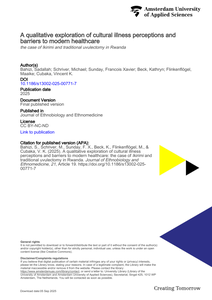Evidence-based research (EBR) is the systematic and transparent use of prior research to inform a new study so that it answers questions that matter in a valid, efficient, and accessible manner. This study surveyed experts about existing (e.g., citation analysis) and new methods for monitoring EBR and collected ideas about implementing these methods. We conducted a cross-sectional study via an online survey between November 2022 and March 2023. Participants were experts from the fields of evidence synthesis and research methodology in health research. Open-ended questions were coded by recurring themes; descriptive statistics were used for quantitative questions. Ideas proposed in this study for monitoring the implementation of EBR can be used to refine methods and define responsibility but should be further explored in terms of feasibility and acceptability. Different methods may be needed to determine if the use of EBR is improving over time.
MULTIFILE

Background: In general people after stroke do not meet the recommendations for physical activity to conduct a healthy lifestyle. Programs to stimulate walking activity to increase physical activity are based on the available insights into barriers and facilitators to physical activity after stroke. However, these programs are not entirely successful. The purpose of this study was to comprehensively explore perceived barriers and facilitators to outdoor walking using a model of integrated biomedical and behavioral theory, the Physical Activity for people with a Disability model (PAD). Methods: Included were community dwelling respondents after stroke, classified ≥ 3 at the Functional Ambulation Categories (FAC), purposively sampled regarding the use of healthcare. The data was collected triangulating in a multi-methods approach, i.e. semi-structured, structured and focus-group interviews. A primarily deductive thematic content analysis using the PAD-model in a framework-analysis’ approach was conducted after verbatim transcription. Results: 36 respondents (FAC 3–5) participated in 16 semi-structured interviews, eight structured interviews and two focus-group interviews. The data from the interviews covered all domains of the PAD model. Intention, ability and opportunity determined outdoor walking activity. Personal factors determined the intention to walk outdoors, e.g. negative social influence, resulting from restrictive caregivers in the social environment, low self-efficacy influenced by physical environment, and also negative attitude towards physical activity. Walking ability was influenced by loss of balance and reduced walking distance and by impairments of motor control, cognition and aerobic capacity as well as fatigue. Opportunities arising from household responsibilities and lively social constructs facilitated outdoor walking. Conclusion: To stimulate outdoor walking activity, it seems important to influence the intention by addressing social influence, self-efficacy and attitude towards physical activity in the development of efficient interventions. At the same time, improvement of walking ability and creation of opportunity should be considered
DOCUMENT

BackgroundUnderstanding cultural perceptions of illness is crucial for effective healthcare delivery. This study examines the ethnomedical concept of ikirimi, a culturally recognized illness in Rwanda characterized by perceived uvula abnormalities, and its traditional management through uvulectomy. This study explores the cultural understanding of ikirimi, its perceived causes, symptoms, and treatments, as well as barriers to integrating modern healthcare.MethodsAn exploratory qualitative approach was employed, involving in-depth semi-structured interviews with eight participants: traditional healers, individuals who underwent traditional uvulectomy, and healthcare providers. A grounded theory approach which analyzes data in systematic manner to generate new theories was applied, with coding conducted in English after initial transcription and analysis in Ikinyarwanda to preserve Indigenous concepts.ResultsParticipants described ikirimi as an illness affecting the uvula (named as akamironko or akamirabugari or agashondabugari in Ikinyarwanda), characterized by swelling, elongation, and pus-like discoloration. Reported symptoms included fever, difficulty swallowing, coughing, and weakness, with children identified as the most affected group. Traditional healers diagnosed ikirimi through visual inspection of uvular morphology and movement and treated it by cutting the affected part of uvula and is known as guca Ikirimi ‘traditional uvulectomy’. Barriers to integrating modern healthcare included skepticism about biomedical care, judgmental attitudes from providers, and communication gaps. Despite the prevalence of ikirimi, its biomedical correlates remain unclear, though participants associated it with severe throat illnesses such as tonsillopharyngitis.ConclusionThe findings highlight ikirimi as a socially constructed illness with deep cultural roots, significant health implications, and persistent barriers to modern healthcare. Addressing these barriers requires culturally sensitive approaches that integrate Indigenous knowledge with biomedical practices. Future research should explore the biomedical correlates of ikirimi and foster collaboration between traditional and modern healthcare systems to improve patient outcomes.
DOCUMENT
